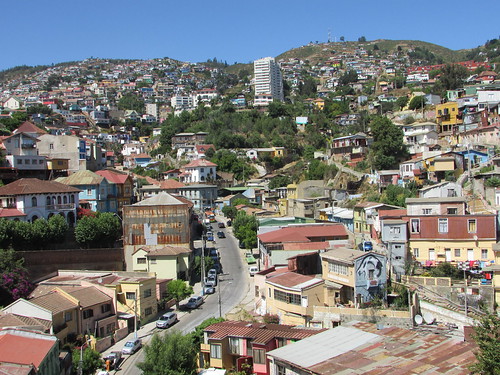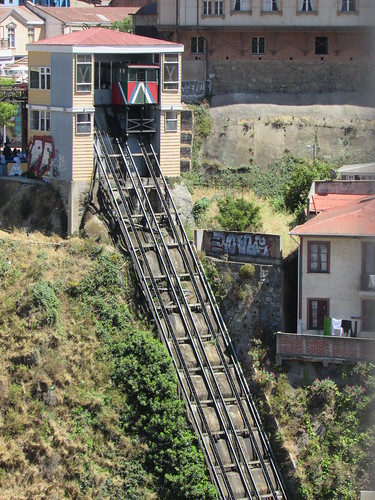I took breakfast in the pleasant restaurant at my hotel before rushing around completing my packing ready for an eight o’clock pick-up. My guide and driver arrived on time and were soon threading our way through the narrow streets of Barrio Lastarria to reach the main road west. Being a working day, the traffic was much heavier than the previous day and our progress was slow. Eventually, we passed Estacion Central, where a huge stylised Christmas Tree (basically a decorated cone) had already been erected. We then traversed Alameda, a rather down-at-heel area which gave way to a series of huge multi-storey modern apartment blocks still under construction. Finally, we left the city behind and climbed into the hills, heading for Valparaiso.
The hills were arid and sandy, covered with trees and shrubs, rising to frequent peaks, each peak topped with a cluster of red and white painted radio masts. In one area, palls of smoke were rising where a hillside was burning but no flames were visible as we sped by on the dual carriageway. In a number of places on downhill sections emergency lanes were provided, terminated in a steep upwards ramp to slow vehicles having difficulty braking. Periodically, we passed broad toll stations which manually collected tolls although a few automatic lanes had been added to one side. Our route took us through two 2-bore road tunnels which allow easier gradients.
After passing through the first mountain section, we emerged into a broad, fertile valley, filled with fruit farms. We stopped at a roadside café which specialises in selling the local sweet pastries so that my guide could take breakfast then continued into the area specialising in olives and grapes. Chile has developed a successful and well-regarded wine making industry and we passed a number of wineries.
Another mountain section led to a modern industrialised area before we entered Valparaiso. I was told the population was around 400,000 and the city certainly appeared larger than I remembered from my earlier visit some years ago. There was plenty of nondescript property but also attractive buildings in classical style dating from the late nineteenth and early twentieth century. Until the Panama Canal opened, Valparaiso was an important port on the sea route from the east to the west coasts of the United States, helping to bring prosperity to Chile’s main port.
Although Valparaiso provided a safe harbour, the location was less than ideal for a city, as numerous steep hills tumble onto a narrow foreshore. Once the foreshore was colonised, further development extended into the hills, resulting in a complex pattern of winding, narrow streets with houses perched on improbable sites, linked together by a series of daunting pedestrian stairways.

Valparaiso, Chile.
This topography resulted in a number of funicular railways (‘Ascensor’) being constructed around the town, linking the foreshore area with the summits of the various hills. At one time, I believe there were around 16 separate funicular railways in the city but a number have fallen into disuse. On my last visit, I found a number of the Ascensor to be in a poor state of maintenance and now, I was told, they are operated by the Government. Unforunately, my present visit coincided with the third week of a strike of Government workers affecting Valparaiso. One consequence of this strike was the piles of uncollected rubbish dumped on every street corner: another was that the Ascensors were not operating so my activities were confined to taking a few photographs. I’m sure I’ll return to this topic in the future.

The Ascensors of Valparaiso.
It was a warm, sunny day in Valparaiso. By car and by walking, my guide showed me more of the city. The older area is now a World Heritage Site and there is a thriving artistic community. Tourism has developed and the good port facilities encourage large cruise ships to call but (as I was able to confirm from one of the viewpoints we stopped at high above the harbour) ‘Silver Explorer’ was the only passenger ship visiting at the time. Some of the old buildings on the hillsides have been converted into hotels to cater for tourists but, of course, Valparaiso can be readily reached by day trip from Santiago. We passed a number of well-patronised walking tours as we made our way around the old town.
With land at a premium, gardens are virtually unknown but every spare space is filled with trees, bushes and planters. The top of one hill is occupied by two Catholic cemeteries (called, prosaically, ‘Cementerio 1’ and ‘Cementerio 2’). Freedom of worship arrived relatively late so the third, non-Catholic cemetery is called, rather uncharitably I thought, the Dissidents’ Cemetery (‘Cementerio Disidente’). The entrance to each of the Catholic cemeteries is graced by a tall, columned arch in classical style, still imposing but now showing signs of age.

Cemeterio No. 1, Valparaiso.
In contrast, the Dissidents’ Cemetery makes do with a simple iron gate set in a white-painted wall. The actual monuments in the various graveyards are of a similar range of styles.
Although there are conventionally-built properties in the old town, a common technique was to use timber framing with corrugated iron sheets for the exterior walls and roof. Occasionally, walls were clapboard. With walls painted in various muted (or, perhaps, faded) colours, the overall effect is pleasing and rather English-looking. This is not accidental as a number of the early settlers in Valparaiso we of English origin. In general, the narrow streets were cobbled, sometimes with two parallel rows of larger stone flags, presumably to aid the movement of wagons and carts.

Valparaiso, Chile.
After a fascinating morning in Valparaiso, the car descended to the foreshore and took the road around the bay as far as the area known as Baron (offering fleeting glimpses of the Baron Ascensor) before entering the Dock Estate Gates. After a cursory, friendly security check, we headed back in the direction we’d arrived from, but now inside the dock walls. A second brief security check allowed us past the Valparaiso Cruise Terminal, a modern steel-framed warehouse, to a parking area near a small building which appeared to contain baggage X-ray equipment. A desk had been set up in the sun where joining passengers’ names were being checked against a series of lists and baggage separated for separate transfer to the ship by lorry. I said ‘good bye’ to my guide and driver and, within moments, I was being walked through the empty barn of the Cruise Terminal (intended for handling two or three thousand passengers at a time off the cruise ships) back outside. Here, I waited with a small group of passengers for a couple of minutes whilst a modern tour bus marked ‘Shuttle’ was prepared by the driver before being driven further into the docks to stop on the quay alongside ‘Silver Explorer’, my home for the next few days.

'Silver Explorer' at Valparaiso.
Related Posts
Next post describing this trip: 'Silver Explorer'.
All posts describing this trip: Chilean Fjords.
My pictures
Where necessary, clicking on an image above will display an 'uncropped' view or, alternately, pictures may be selected, viewed or downloaded, in various sizes, as below:-
Pictures of Valparaiso are here.
Pictures embarking at Valparaiso are here.
All my pictures of Chile, taken on this and earlier trips, can be found in the collection Chile.
Pictures of the railways in Chile including the Metros in Santiago and Valparaiso, taken on this and earlier trips, are here.
[Pictures added: 28-Dec-2016]
